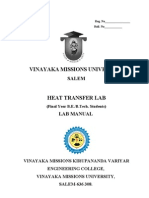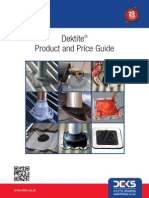MTV 410 Exam June 2012
MTV 410 Exam June 2012
Uploaded by
Wesley BothaCopyright:
Available Formats
MTV 410 Exam June 2012
MTV 410 Exam June 2012
Uploaded by
Wesley BothaOriginal Description:
Copyright
Available Formats
Share this document
Did you find this document useful?
Is this content inappropriate?
Copyright:
Available Formats
MTV 410 Exam June 2012
MTV 410 Exam June 2012
Uploaded by
Wesley BothaCopyright:
Available Formats
THERMOFLOW MTV410
JUNE 2012
Examiners / Eksaminatore Prof JP Meyer, PhD, PrEng. Professor and Head, University of Pretoria Prof TT Chandratilleke, PhD (Cambridge), Professor and Head, Curtin University, Australia
INSTRUCTIONS 1. Time: 3 hours 2. Full marks: 100 3. Answer all the questions 4. Start every question on a new page 5. Neatness makes it easier to identify marks 6. Make sketches to identify points and nomenclature
QUESTION 1 [10] During a picnic on a hot summer day, all the cold drinks disappeared quickly, and the only available drinks were those at the ambient temperature of 30C. In an effort to cool a 350 mL drink in a can, which is 130 mm high and has a diameter of 65 mm, a person grabs the can and starts shaking it in the iced water of the chest at 0C. The temperature of the drink can be assumed to be uniform at all times, and the heat transfer coefficient between the iced water and the aluminum can is 170 W/m2.K. Using the properties of water for the drink, estimate how long it will take for the canned drink to cool to 4C. Give a motivation for the method/approach being used. QUESTION 2 [15] White potatoes (k = 0.50 W/m.K and = 0.13E-6 m2/s) that are initially at a uniform temperature of 25C and have an average diameter of 60 mm are to be cooled by refrigerated air at 2C flowing at a velocity of 4 m/s. The average heat transfer coefficient between the potatoes and the air is experimentally determined to be 19 W/m2.K. Determine how long it will take for the center temperature of the potatoes to drop to 6C. Also, determine if any part of the potatoes will experience chilling during the process. Use the analytical method (not the graphical solution). QUESTION 3 [10] Consider a 50-cm-diameter and 95-cm-long hot water tank. The tank is placed on the roof of a house. The water inside the tank is heated to 80C by a flat-plate solar collector during the day. The tank is then exposed to windy air at 18C with an average velocity of 40 km/h during the night. Estimate the temperature of the tank after 45-min. Assume the tank temperature to be at the same temperature as the water inside, and the heat transfer coefficient on the top and bottom surfaces to be the same as that on the side surface.
QUESTION 4 [15] Hot water at 90C enters a 15-m section of a cast iron pipe (k = 52 W/m.K) whose inner and outer diamters are 40 mm and 46 mm, respectively, at an average velocity of 1.2 m/s. The outer surface of the pipe, whose emissivity is 0.7, is exposed to the cold air at 10C in a basement, with a convection heat transfer coefficient of 12 W/m2.K. Taking the walls of the basement to be at 10C also, determine (a) the rate of heat loss from the water and (b) the temperature at which the water leaves the basement. QUESTION 5 [15] A 15-cm-wide and 18-cm-high vertical hot surface in 25C air is to be cooled by a heat sink with equally spaced fins of rectangular profile. The fins are 0.1 cm thick and 18 cm long in the vertical direction. Determine the optimum fin height and the rate of heat transfer by natural convection from the heat sink if the base temperature is 85C. The criterion for optimum fin height H in the literature is given by
H hAc / pk . Take the thermal conductivity of fin material to be 177 W/m.K.
QUESTION 6 [20] A counter-flow double pipe heat exchanger with As=9.0 m2 is used for cooling a liquid stream (Cp=3.15 kJ/kg.K) at a rate of 10.0 kg/s with an inlet temperature of 90C. The coolant (Cp = 4.2 kJ/kg.K) enters the heat exchanger at a rate of 8.0 kg/s with an inlet temperature of 10C. The plant data gave the following equation for the overall heat transfer coefficient in W/m2.K: are the cold-and hot-stream flow rates in kg/s, respectively. (a) Calculate the rate of heat transfer and the outlet stream temperatures for this unit. (b) The existing units is to be replaced. A vendor is offering a very attractive discount on two identical heat exchangers that are presently stocked in its warehouse, each with As=5.0 m2. Because the tube diameters in the existing and new units are the same, the above heat transfer coefficient equation is expected to be valid for the new units as well. The vendor is proposing that the two new units could be operated in parallel, such that each unit would process exactly one-half the flow rate of each of the hot and cold streams in a counterflow manner; hence, they together would meet (or exceed) the present plant heat duty. Give your recommendation, with supporting calculations, on this replacement proposal. QUESTION 7 [15] A thin-walled double-pipe parallel flow heat exchanger is used to heat a chemical whose specific heat is 1 800 J/kg.K, with hot water (Cp = 4 180 J/kg.K). The chemical enters the heat exchanger at 20C at a rate of 3 kg/s, while the water enters at 110C at a rate of 2 kg/s. The heat transfer surface area of the heat exchanger is 7 m2 and the overall heat transfer coefficient is 1 200 W/m2.K. Determine the outlet temperatures of the chemical and the water.
0.8 0.8 U 600 / (1/ mc 2 / mh ) , where mc and mh
Source: Cengel (2006) END/EINDE MEMO OF THIS PAPER IS ON CLICKUP MEMORANDUM VAN HIERDIE VRAESTEL IS OP CLICKUP/
You might also like
- Shigley Formula SheetDocument12 pagesShigley Formula SheetWesley Botha100% (1)
- Painting Procedure PDFDocument13 pagesPainting Procedure PDFDominik100% (1)
- Astm Volume 01.01Document4 pagesAstm Volume 01.01Carlos Rivera0% (1)
- War Horse - Theme Analysis EssayDocument4 pagesWar Horse - Theme Analysis Essayapi-308070012No ratings yet
- Tutorial 5 TFP260S PDFDocument2 pagesTutorial 5 TFP260S PDFHundzukani Ngobeni100% (1)
- Unit 10 Reading Explorer 2Document16 pagesUnit 10 Reading Explorer 2Ngọc Quyên NguyễnNo ratings yet
- A Christmas CarolDocument14 pagesA Christmas CarolDaniela KostadinovaNo ratings yet
- Practice Questions Me341Document4 pagesPractice Questions Me341mdprv5167rkNo ratings yet
- Che 131 Ps-Heat2Document1 pageChe 131 Ps-Heat2Jelor GallegoNo ratings yet
- Andrew ProbsDocument2 pagesAndrew ProbsGiea Patricze ArcaNo ratings yet
- Examples For Boiling, Condensation and Heat Exchanger-WithDocument9 pagesExamples For Boiling, Condensation and Heat Exchanger-Withphantrongtin414No ratings yet
- ME 307: Heat Transfer Equipment Design: (Arpachi-Ex-7.9)Document5 pagesME 307: Heat Transfer Equipment Design: (Arpachi-Ex-7.9)mz_haqNo ratings yet
- Penjelasan Tentang KoperasiDocument9 pagesPenjelasan Tentang Koperasiimam luthfiNo ratings yet
- Assignment - Process Heat Transfer (CDB2023)Document4 pagesAssignment - Process Heat Transfer (CDB2023)qrunchyNo ratings yet
- Problemas en Clase 13Document6 pagesProblemas en Clase 13Junior Pucuhuanca SullcaNo ratings yet
- Assignment 2 HT CHE F241Document2 pagesAssignment 2 HT CHE F241TechY LuciferNo ratings yet
- Tutorial 3 - Revised SolutionDocument11 pagesTutorial 3 - Revised Solutionngoc.nguyenlamNo ratings yet
- Condensation and Boiling 1Document1 pageCondensation and Boiling 1onyxNo ratings yet
- Tutorial 8Document3 pagesTutorial 8CHANDAN RAJNo ratings yet
- THERMMODNAMICS 1 - PROB SET #2Document1 pageTHERMMODNAMICS 1 - PROB SET #2sonic02.socialsNo ratings yet
- Practica 2 PRQ 2203 I - 2024Document7 pagesPractica 2 PRQ 2203 I - 2024Cruz Paniagua Rene AngelNo ratings yet
- Assignment 1 Basic of Heat TransferDocument2 pagesAssignment 1 Basic of Heat TransferAnkit MehrotraNo ratings yet
- Class Tutorials On Convection Heat TransferDocument2 pagesClass Tutorials On Convection Heat TransferSimon OsemboNo ratings yet
- Soal KONDUKTIVITASDocument2 pagesSoal KONDUKTIVITASSupriyantiNo ratings yet
- Prob Sheet Heat ExchangerDocument2 pagesProb Sheet Heat ExchangerAnonymous mXicTi8hB0% (1)
- HMT Tut1Document2 pagesHMT Tut1Meet ShahNo ratings yet
- 5.1 Prob - Sheet.entropyDocument2 pages5.1 Prob - Sheet.entropyShrinivas Subhash HulsureNo ratings yet
- Heat Transfer Lab ManualDocument43 pagesHeat Transfer Lab ManualNarasimharajan ManiNo ratings yet
- ExamDocument3 pagesExamBiyadgie AlebelNo ratings yet
- PS Compilation For 2019Document10 pagesPS Compilation For 2019Nicole RamirezNo ratings yet
- MEL301 2014 Tutorial4 Draft Version 01 PDFDocument2 pagesMEL301 2014 Tutorial4 Draft Version 01 PDFAkhil NekkantiNo ratings yet
- ChE 204 HW-4 and HW-5 Together, Spring 2014, See Changes!Document5 pagesChE 204 HW-4 and HW-5 Together, Spring 2014, See Changes!Irene Kaye AceroNo ratings yet
- Practica 3 PRQ 2203 I - 2024Document6 pagesPractica 3 PRQ 2203 I - 2024Cruz Paniagua Rene AngelNo ratings yet
- TALLER CORTE II EnergíaDocument2 pagesTALLER CORTE II EnergíaNicolas VelásquezNo ratings yet
- C5 ExerciseDocument18 pagesC5 ExerciseHƯƠNG NGUYỄN LÊ NGỌCNo ratings yet
- Practice Questions 2024Document8 pagesPractice Questions 2024leapokhutsoNo ratings yet
- PS Chapter11Document6 pagesPS Chapter11x비No ratings yet
- Problem Set 1Document6 pagesProblem Set 1Emilee Noven RamirezNo ratings yet
- Tutorial 3 SolutionDocument5 pagesTutorial 3 Solutionngoc.nguyennhuNo ratings yet
- Prob Set Heat and MassDocument15 pagesProb Set Heat and MassCheng PasionNo ratings yet
- Tut 4 Heat ExchangersDocument2 pagesTut 4 Heat ExchangersGomolemo BaarxxNo ratings yet
- A3 - Tutorial Problems - Heat Exchangers Feb 2024Document12 pagesA3 - Tutorial Problems - Heat Exchangers Feb 2024RAPELANG MORAPEDINo ratings yet
- Exerci Cio S Trans Ferenc I A Decal orDocument8 pagesExerci Cio S Trans Ferenc I A Decal orclarice.pinheiroNo ratings yet
- Tutorial 7 Heat ExchangersDocument2 pagesTutorial 7 Heat ExchangersLoago IshokoNo ratings yet
- Tugas 2 TMK 3Document2 pagesTugas 2 TMK 3Arif Fuji HariyantoNo ratings yet
- Numerical Problems LMTDDocument4 pagesNumerical Problems LMTDKhalidNo ratings yet
- Assignment For HeatDocument1 pageAssignment For HeatJeramie CanoNo ratings yet
- Exercise - Transport ProcessesDocument3 pagesExercise - Transport ProcessesJan Mark Fongfar0% (1)
- Assignment 2Document2 pagesAssignment 2ZakwanNo ratings yet
- ME-306_TOPIC-6Document32 pagesME-306_TOPIC-6DG Deku YTNo ratings yet
- Solution HEAT EXCHANGER-SHEETDocument11 pagesSolution HEAT EXCHANGER-SHEETfelopateermadNo ratings yet
- Heat Exchanger 2Document64 pagesHeat Exchanger 2John Louie Gresula100% (1)
- Heat Exchanger Tutorial 1 PDFDocument2 pagesHeat Exchanger Tutorial 1 PDFNitin BuZz100% (1)
- 16TF603 Entropy AssignmentDocument2 pages16TF603 Entropy AssignmentMd Sharique AkhtarNo ratings yet
- Tutorial Questions On Heat Ex ChangersDocument3 pagesTutorial Questions On Heat Ex ChangersPuneet Garg100% (1)
- HT Assignment U-4Document1 pageHT Assignment U-4ajayteja1080No ratings yet
- 515MET02 HMT Unit 3 FinalDocument4 pages515MET02 HMT Unit 3 Finalntamilselvan.eecNo ratings yet
- AssigDocument2 pagesAssigZakwan0% (1)
- Heat & Mass Transfer Ex5Document2 pagesHeat & Mass Transfer Ex5mekdimNo ratings yet
- Assignment HXDocument2 pagesAssignment HXAbhilash TilakNo ratings yet
- MT Prob Set 2Document6 pagesMT Prob Set 2wqesaddsNo ratings yet
- Mechanics of the Household: A Course of Study Devoted to Domestic Machinery and Household Mechanical AppliancesFrom EverandMechanics of the Household: A Course of Study Devoted to Domestic Machinery and Household Mechanical AppliancesNo ratings yet
- Semester Test 1 - 2008 Memo PDFDocument7 pagesSemester Test 1 - 2008 Memo PDFWesley BothaNo ratings yet
- MTV 410 Semester Test 1 Memo March 2012Document6 pagesMTV 410 Semester Test 1 Memo March 2012Wesley BothaNo ratings yet
- MTV 410 Study GuideDocument43 pagesMTV 410 Study GuideWesley BothaNo ratings yet
- Dynamics Formula SheetDocument2 pagesDynamics Formula SheetWesley BothaNo ratings yet
- Lecture On The Dot & Cross Product PDFDocument4 pagesLecture On The Dot & Cross Product PDFWesley BothaNo ratings yet
- MSY 310 - Semester Test (24.04.2012) - MEMODocument17 pagesMSY 310 - Semester Test (24.04.2012) - MEMOWesley BothaNo ratings yet
- Section Properties Steel Profilesrev2 4Document9 pagesSection Properties Steel Profilesrev2 4Wesley BothaNo ratings yet
- WEB NTSBprelim3:6:18Document2 pagesWEB NTSBprelim3:6:18Honolulu Star-Advertiser0% (1)
- Indoor Thermal Environment in Tropical Climate Residential BuildingDocument5 pagesIndoor Thermal Environment in Tropical Climate Residential BuildingMimi SamsudinNo ratings yet
- Dektite Prod Price Guide 0912Document6 pagesDektite Prod Price Guide 0912micnunNo ratings yet
- GH GasDocument34 pagesGH GasDamisha DamishaNo ratings yet
- Anh 11 - U6-PRACTICEDocument4 pagesAnh 11 - U6-PRACTICEAss Potato100% (2)
- PGL QuestionsDocument14 pagesPGL Questionspowboy1No ratings yet
- IESO Question Papers (2007-2009)Document136 pagesIESO Question Papers (2007-2009)Science Olympiad Blog67% (3)
- English Test 10 THDocument4 pagesEnglish Test 10 THMarco MolinaNo ratings yet
- IMPRESO 13 Askeland Chap PDFDocument8 pagesIMPRESO 13 Askeland Chap PDFSaby Hellen FlorecinNo ratings yet
- Oumh2103 (Rosnawati Jaim 731023125308002)Document11 pagesOumh2103 (Rosnawati Jaim 731023125308002)Rosnawati JaimNo ratings yet
- LearningTask1 FACTORS AFFECTING WEATHERINGDocument1 pageLearningTask1 FACTORS AFFECTING WEATHERINGGerald BajadoNo ratings yet
- ArenaB1-Transkriptionen_OLDocument59 pagesArenaB1-Transkriptionen_OLPHUONGNo ratings yet
- Hillman 1946, Education in BurmaDocument9 pagesHillman 1946, Education in Burmaschissmj100% (2)
- Multiple Choice Cloze CaeDocument10 pagesMultiple Choice Cloze CaeLaloNo ratings yet
- FireworksDocument4 pagesFireworksKeisha Mae KingayNo ratings yet
- analysisDocument6 pagesanalysislaha03manahiraNo ratings yet
- Yuz Adet Cumle Tamamlama SorusuDocument14 pagesYuz Adet Cumle Tamamlama Sorusumoonwalker18No ratings yet
- Concrete Roof Pavers: Standard Specification ForDocument4 pagesConcrete Roof Pavers: Standard Specification Forasemamaw damtieNo ratings yet
- Unidad No 2 de Ingles 4Document8 pagesUnidad No 2 de Ingles 4robelioNo ratings yet
- Test Engleza Clasa A X-ADocument3 pagesTest Engleza Clasa A X-AIazmina MarcuNo ratings yet
- C210 WML 208Document9 pagesC210 WML 208Efrén SantínNo ratings yet
- Water Tank PressureDocument9 pagesWater Tank PressureWilliam Boyle Jr.No ratings yet
- Chap03 PDFDocument46 pagesChap03 PDFSteve E PutterNo ratings yet
- METAR/TAF Code Glossary: Weather DescriptorsDocument4 pagesMETAR/TAF Code Glossary: Weather DescriptorsYeison Chavez100% (1)
- Activity 1 AdjectivesDocument1 pageActivity 1 AdjectivesNoemie LongcayanaNo ratings yet
- Untitled DocumentDocument9 pagesUntitled DocumentAbid RehmanNo ratings yet
- Caring For Phalaenopsis OrchidsDocument2 pagesCaring For Phalaenopsis OrchidsHana BertianiNo ratings yet
- Operations Management CaseDocument10 pagesOperations Management Casebeyiii100% (1)

































































































